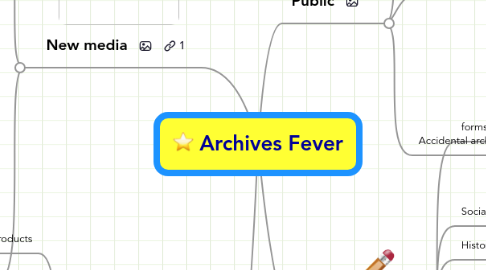
1. New media
1.1. Instant information architecture
1.1.1. Real-time
1.1.2. Devices
1.1.2.1. Smart Phones
1.1.2.1.1. iPhone
1.1.2.1.2. Motorola
1.1.2.1.3. HTC
1.1.2.2. Tablets
1.1.2.2.1. Kindle
1.1.2.2.2. iPad
1.1.2.2.3. Samsung Galazy Tab
1.1.2.2.4. Sony
1.1.3. Social Network
1.1.3.1. Twitter
1.1.3.2. Facebook
1.1.3.3. Tumblr
1.1.3.4. Youtube
1.1.4. Permanent Record
1.1.5. Content management system
1.1.5.1. WordPress
1.1.5.2. Youtube
1.1.5.3. Blackboard
1.2. Application Program Interface
1.2.1. No Limits
1.2.2. User's history
1.2.2.1. Track down
1.2.2.2. Retrieve
1.2.3. Faster infrastructure
1.2.4. Real-time updates
2. Archivication
2.1. Products
2.1.1. Event records
2.1.2. archieving archieve
2.1.2.1. archivable content
2.2. Future relationship
2.2.1. Opens up future
2.2.2. Never ends
2.3. Existence
2.3.1. Selective documentation
2.3.2. Fragmentation
2.3.3. Discontinuities
2.3.3.1. Nothing starts
2.3.3.2. Unfinished stories
2.3.4. Lost
2.3.4.1. Unread
2.3.4.2. Unnoted
2.3.4.3. Untranscribed
3. Public
3.1. discontnted masses
3.1.1. search engines optimizers
3.1.2. bloggers
3.2. online public archieve
3.2.1. Search engines
3.2.1.1. Google
3.2.1.2. Yahoo
3.2.2. My School
3.2.2.1. Australian schools profile
3.2.3. Apartheid Archives project
3.2.4. Disaster experiences sharing
3.2.4.1. Cyclone Yasi
3.2.4.2. Hurricane Archive
3.2.5. Web publishing platform
3.2.5.1. Omeka
3.3. Accidental archivers
3.3.1. Self-archive
4. Written
4.1. forms
4.1.1. parchments
4.1.2. Old papers
4.1.3. leather
4.1.4. ink
4.2. Social histories
4.3. Historicians
4.4. Storage
4.4.1. catalogued
4.4.2. Box
4.4.3. Folders
4.4.4. Bound up
4.4.5. wax sealed
4.4.6. problems
4.4.6.1. bad handwriting
4.4.6.2. rotting
4.4.6.3. Dust
